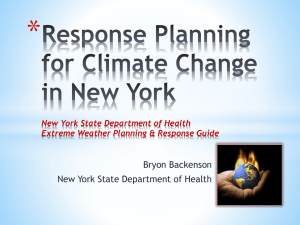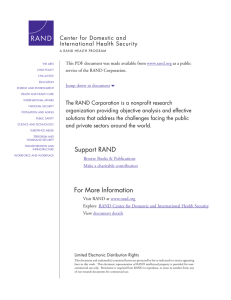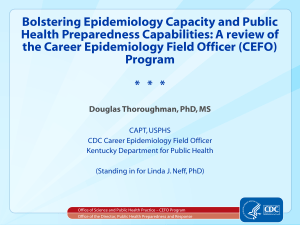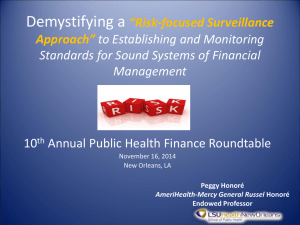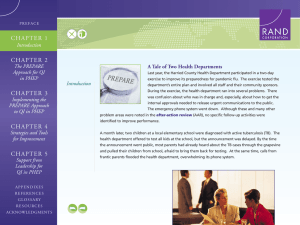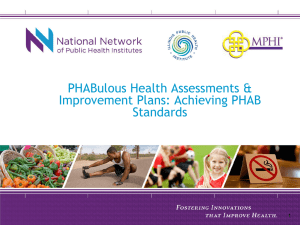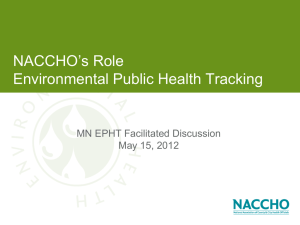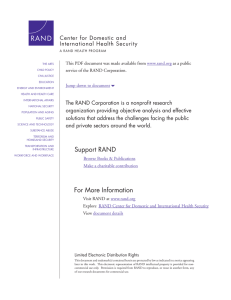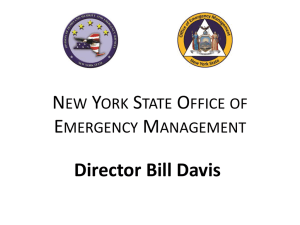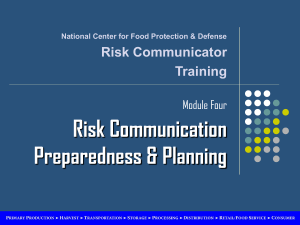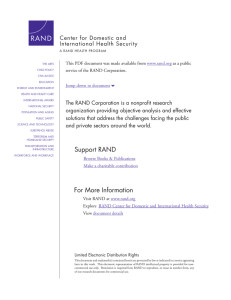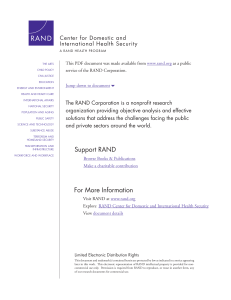Public Health Accreditation and Emergency Preparedness
advertisement
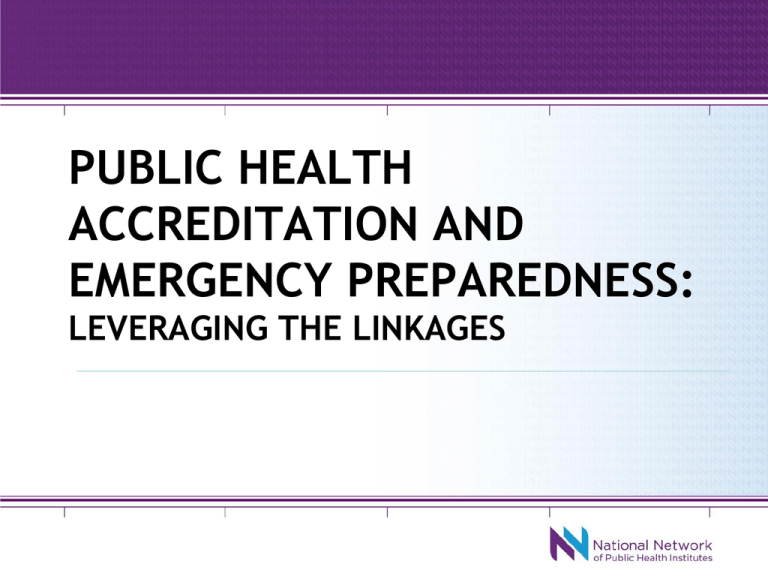
PUBLIC HEALTH ACCREDITATION AND EMERGENCY PREPAREDNESS: LEVERAGING THE LINKAGES Public Health Preparedness: Standards and Performance Measures Resham Patel, MPH Senior Program Analyst, Preparedness, NACCHO COPPHI Open Forum December 6, 2012 Importance of Standards and Performance Measures in Preparedness • Measures progress on preparedness capabilities and capacities • Demonstrates return on investment of federal and state funding • Informs state and local public health, policy makers, key preparedness partners and other stakeholders • Provides a framework to ensure that public health preparedness is meeting national standards PPHR, PHEP, and PHAB: An Overview • Set a standard of achievement for performance for local health departments • NACCHO’s PPHR criteria address preparedness and response, specifically in planning, training, and demonstration of readiness. • CDC’s PHEP capabilities assist state and local planners in identifying gaps, determining priorities, and developing plans for building and sustaining capabilities. • PHAB’s standards address global organizational and system-wide agency capacity and capability. PPHR, PHEP, and PHAB: A Shared History • Since the early 2000’s, PPHR and PHEP have focused on building public health preparedness capacity and capability at the state and local level. • PPHR criteria contributed to the development of the PHEP capabilities, creating strong synergy between the programs. • PHAB referenced the PPHR criteria, and the newly released PHEP capabilities, in developing the accreditation standards and measures. • The PPHR criteria are updated annually to incorporate local practices and the most recent national preparedness initiatives, including PHEP and PHAB. Project Public Health Ready Project Public Health Ready (PPHR) is a collaborative activity between the National Association of County and City Health Officials (NACCHO) and the Centers for Disease Control and Prevention (CDC). Vision Local health departments (LHDs) will be fully integrated into the response community and prepared to respond to any emergency. Mission To protect the public’s health and increase the public health infrastructure by building local health department preparedness capacity and capability. With assistance from state health departments, LHDs will use sustainable tools to plan, train, and exercise using a continuous improvement model. About PPHR • Piloting began in 2003 • Collaborative activity between NACCHO and CDC • PPHR Workgroup • Committee developed criteria, led by local public health practitioners • 285 LHDs recognized individually or as part of a region • Utilizes a continuous quality improvement process • Develops Community Partnerships Project Public Health Ready * New States PPHR Criteria PPHR Criteria are divided into three goals: 1. All-Hazards Response Plan 2. Workforce Development 3. Demonstration of Readiness: Exercise or Event PPHR Criteria Updated annually and aligned with federal guidelines and national initiatives, including: • National Health Security Strategy (NHSS) • CDC Public Health Emergency Preparedness (PHEP) Capabilities • National Incident Management System (NIMS) • Homeland Security Exercise & Evaluation Program (HSEEP) Public Health Emergency Preparedness (PHEP) Cooperative Agreement • Public Health Emergency Preparedness (PHEP) Cooperative Agreements are between CDC and the 50 states, 8 territories, and 4 directly funded cities (NY, Chicago, DC, and LA) • Appropriated by Congress in 2002 • In 2011, CDC released 15 Public Health Preparedness Capabilities which were designed to align with the National Health Security Strategy • PHEP funding will be used by grantees to work towards these capabilities PHEP: 15 Capabilities Community Preparedness Community Recovery Emergency Operations Coordination Emergency Public Information and Warning Fatality Management Information Sharing Mass Care Medical Countermeasure Dispensing Medical Materiel Management and Distribution Medical Surge Non-Pharmaceutical Interventions Public Health Laboratory Testing Public Health Surveillance and Epidemiological Investigation Responder Safety and Health Volunteer Management Preparedness Capabilities Structure 15 Preparedness Capabilities Capability 3-5 broad “Functions” per Capability Functions A number of Essential Tasks for completion of each Function Essential Tasks Tasks form the basis for training and exercises Capability Definition Resource Elements include owning or, where applicable, having access to: Resource Elements 1. Plans (includes vulnerable populations, legal authorities) 2. Skills and Training 3. Equipment and Technology Application Work Plan Component Office of Public Health Preparedness and Response Division of State and Local Readiness PHAB Framework: Domains, Standards, and Measures 12 Domains (10 Essential PH services plus administration & governance) ~ Standards ~ Measures Documentation Public Health Accreditation Board (PHAB) NACCHO’s Document Selection Tool: PPHR and accreditation NACCHO’s PPHR Workgroup members were involved with the PHAB Standards and Measures development. This tool highlights 2012 PPHR Criteria that correlate to current PHAB Standards and Measures. Completed in November 2012, and available online at www.naccho.org/topics/infrastructure/accreditation/upload/ DST-PPHR.pdf NACCHO’s Document Selection Tool: PPHR and accreditation NACCHO’s Document Selection Tool: PPHR and accreditation Examples Questions? Resham Patel, MPH Senior Program Analyst, Public Health Preparedness National Association of County and City Health Officials Phone: 202-507-4233 E-mail: rpatel@naccho.org
